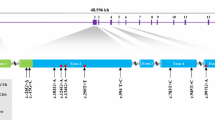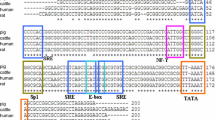Abstract
The UBX domain containing protein 1-like gene (UBXN1) promotes the protein degradation that affects meat quality, in particular traits related to water holding capacity. The aim of our study was to identify UBXN1 polymorphisms and to analyse their association with meat quality traits. Moreover, the relationship of UBXN1 polymorphisms and its transcript abundance as well as the link between UBXN1 expression and water holding capacity were addressed. Pigs of the breed German landrace (GL) and the commercial crossbreed of Pietrain × [German large white × GL] (PiF1) were used for this study. In GL, the novel SNP c.355 C > T showed significant association with conductivity and drip loss (P ≤ 0.05). Another SNP at nt 674 of the coding sequence [SNP c.674C>T (p.Thr225Ile)] was associated with drip loss (P ≤ 0.05) and pH1 (P ≤ 0.1). In PiF1, the SNP UBXN1 c.674C>T was associated with conductivity (P ≤ 0.01). Moreover, the haplotype combinations showed effects on conductivity within both commercial populations at P ≤ 0.1. In both populations, high expression of UBXN1 tended to decrease water holding capacity in the early post mortem period. The analysis of triangular relationship of UBXN1 polymorphism, transcript abundance, and water holding capacity evidences the existence of a causal polymorphism in cis-regulatory regions of UBXN1 that influences its expression.


Similar content being viewed by others
References
Huff-Lonergan E, Lonergan SM (2005) Mechanisms of water-holding capacity of meat: the role of postmortem biochemical and structural changes. Meat Sci 71(1):194–204
Melody JL, Lonergan SM, Rowe LJ, Huiatt TW, Mayes MS, Huff-Lonergan E (2004) Early postmortem biochemical factors influence tenderness and water-holding capacity of three porcine muscles. J Anim Sci 82:1195–1205
Attaix D, Combaret L, Pouch M-N, Taillandier D (2002) Cellular control of ubiquitin-proteasome-dependent proteolysis. J Anim Sci 80(E. Suppl. 2):E56–E63
Chang KC (2007) Key signalling factors and pathways in the molecular determination of skeletal muscle phenotype. Animal 1:681–698
Goll DE, Neti G, Mares SW, Thompson VF (2008) Myofibrillar protein turnover: The proteasome and the calpains. J Anim Sci 86(E. Suppl.):E19-E35
Lecker SH, Goldberg AL, Mitch WE (2006) Protein degradation by the ubiquitin–proteasome pathway in normal and disease states. J Am Soc Nephrol 17:1807–1819
Voisin L, Breuillé D, Combaret L, Pouyet C, Taillandier D, Aurousseau E, Obled C, Attaix D (1996) Muscle wasting in a rat model of long-lasting sepsis results from the activation of lysosomal, Ca2+-activated, and ubiquitin-proteasome proteolytic pathways. J Clin Invest 97(7):1610–1617
Ponsuksili S, Jonas E, Murani E, Phatsara C, Srikanchai T, Walz C, Schwerin M, Schellander K, Wimmers K (2008) Trait correlated expression combined with expression QTL analysis reveals biological pathways and candidate genes affecting water holding capacity of muscle. BMC Genom 9:367–380
Ponsuksili S, Murani E, Chirawath Phatsara, Jonas E, Walz C, Schwerin M, Schellander K, Wimmers K (2008) Expression profiling of muscle reveals transcripts differentially expressed in muscle that affect water-holding capacity of pork. J Agric Food Chem 56:10311–10317
Damon M, Wyszynska-Koko J, Vincent A (2012) Comparison of muscle transcriptome between pigs with divergent meat quality phenotypes identifies genes related to muscle metabolism and structure. PLoS One 7:33763–33777
Buchberger A, Howard MJ, Proctor M, Bycroft M (2001) The UBX domain: a widespread ubiquitin-like module. J Mol Biol 307:17–24
McNeill H, Knebel A, Arthur JSC, Cuenda A, Cohen P (2004) A novel UBA and UBX domain protein that binds polyubiquitin and VCP and is a substrate for SAPKs. Biochem J 384:391–400
Heuven HC, Wijk RHv, Dibbits B, Kampen TAv, Knol EF, Bovenhuis H (2009) Mapping carcass and meat quality QTL on sus scrofa chromosome 2 in commercial finishing pigs. Genet Sel Evol 41:4–11
Lee SS, Chen Y, Moran C, Cepica S, Reiner G, Bartenschlager H, Moser G, Geldermann H (2003) Linkage and QTL mapping for sus scrofa chromosome 2. J Anim Breed Genet 120(Suppl. 1):11–19
Malek M, Dekkers JCM, Lee HK, Baas TJ, Prusa K, Huff-Lonergan E, Rothschild MF (2001) A molecular genome scan analysis to identify chromosomal regions influencing economic traits in the pig. II. Meat and muscle composition. Mamm Genome 12:637–645
Ponsuksili S, Murani E, Schwerin M, Schellander K, Wimmers K (2010) Identification of expression QTL (eQTL) of genes expressed in porcine M. longissimus dorsi and associated with meat quality traits. BMC Genom 11:572–586
Rohrer GA, Thallman RM, Shackelford S, Wheeler T, Koohmaraie M (2005) A genome scan for loci affecting pork quality in a Duroc–Landrace F2 population. Anim Genet 37:17–27
Wijk HJv, Dibbits B, Baron EE, Brings AD, Harlizius B, Groenen MAM, Knol EF, Bovenhuis H (2006) Identification of quantitative trait loci for carcass composition and pork quality traits in a commercial finishing cross. J Anim Sci 84:789–799
ZDS (2004) Richtlinie für die Stationsprüfung auf Mastleistung, Schlachtkörperwert und Fleischbeschaffenheit beim Schwein. Zentralverband der Deutschen Schweineproduktion eV, Ausschuss fuer Leistungsprüfung und Zuchtwertschaetzung, Bonn
Srikanchai T, Murani E, Wimmers K, Ponsuksili S (2010) Four loci differentially expressed in muscle tissue depending on water-holding capacity are associated with meat quality in commercial pig herds. Mol Biol Rep 37:595–601
Ponsuksili S, Du Y, Murani E, Schwerin M, Wimmers K (2012) Elucidating molecular networks that either affect or respond to plasma cortisol concentration in target tissues of liver and muscle. Genetics 192:1109–1122
Benjamini Y, Hochberg Y (1995) Controlling the false discovery rate: a practical and powerful approach to multiple testing. J R Stat Soc B 57:289–300
Nyam-Osor P, Jayawardana B, Aro JMA, Shimada K-i, Fukushima M, Sekikawa M (2009) Identification of ubiquitin conjugated protein phosphatase inhibitor 1 from postmortem bovine muscle. Food Chem 115:1509–1511
Sekikawa M, Shimada K, Fukushima M, Ishikawa T, Wakamatsu J, Mikami M (2000) Presence of ubiquitin in bovine post-mortem cardiac muscle. Food Chem 69:315–318
Sekikawa M, Yamamoto M, Fukushima M, Shimada K, Ishikawa T, Mikami M (2001) Effect of proteasome inhibitor on sarcoplasmic protein of bovine skeletal muscle during storage. Food Chem 73:17–21
Byrne CE, Troy DJ, Buckley DJ (2000) Postmortem changes in muscle electrical properties of bovine M. longissimus dorsi and their relationship to meat quality attributes and pH fall. Meat Sci 54:23–34
Fischer K (2007) Drip loss in pork: influencing factors and relation to further meat quality traits. J Anim Breed Genet 124(Suppl. 1):12–18
Lee S, Norman JM, Gunasekaran S, Laack RLJMv, Kim BC (2000) Use of electrical conductivity to predict water-holding capacity in post-rigor pork. Meat Sci 55:385–389
Joo ST, Kauffman RG, Laack RLJMv, Lee S, Kim BC (1999) Variations in rate of water loss as related to different types of post-rigor porcine musculature during storage. J Food Sci 64(5):865–868
Kristensen L, Purslow PP (2001) The effect of ageing on the water-holding capacity of pork: role of cytoskeletal proteins. Meat Sci 58:17–23
Schäfer A, Rosenvold K, Purslow PP, Andersen HJ, Henckel P (2002) Physiological and structural events post mortem of importance for drip loss in pork. Meat Sci 61:355–366
Hilenski LL, Terracio L, Haas AL, Borg TK (1992) Immunolocalization of ubiquitin conjugates at Z-bands and intercalated discs of rat cardiomyocytes in vitro and in vivo. J Histochem Cytochem 40(7):1037–1042
Riley DA, Bain JL, Ellis S, Haas AL (1988) Quantitation and immunocytochemical localization of ubiquitin conjugates within rat red and white skeletal muscles. J Histochem Cytochem 36(6):621–632
Schuberth C, Buchberger A (2008) UBX domain proteins: major regulators of the AAA ATPase Cdc48/p97. Cell Mol Life Sci 65:2360–2371
Acknowledgments
This research was partly supported by the German Research Foundation (Deutsche Forschungsgemeinschaft, DFG; WI 1754/14-1) the Ministry of Education and Training of Vietnam, the German Academic Exchange Service (DAAD), and the Cantho University (Vietnam). Thanks are also due to the Pig Breeding Association of Mecklenburg-Western Pommerania.
Author information
Authors and Affiliations
Corresponding author
Rights and permissions
About this article
Cite this article
Loan, H.T.P., Muráni, E., Maak, S. et al. UBXN1 polymorphism and its expression in porcine M. longissimus dorsi are associated with water holding capacity. Mol Biol Rep 41, 1411–1418 (2014). https://doi.org/10.1007/s11033-013-2985-5
Received:
Accepted:
Published:
Issue Date:
DOI: https://doi.org/10.1007/s11033-013-2985-5




